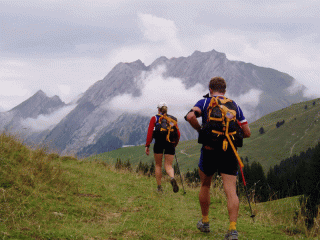For example, the shoulder straps will chafe the skin to the point of bleeding if the race is long enough — it is better to discover the virtue Body Glide before a race, not during one. You should also pay attention to ease of access to your essential kit. For every minute gained through fast running via dedicated training, you can lose twice that in slow transitions and/or an inordinate number of stops to remove your pack to dig for something that should have been accessible on the fly.
Last, ditch your road running shoes for a pair of trail runners that is lightweight, breathable, shock absorbent and grips slippery and uneven surfaces.
Kayak/Canoe
Many adventure racers neglect kayak/canoe training relative to the time spent on running and biking, and this presents the best
opportunity for AR rookies looking to cut the competition’s lead early in the game.
Kayaking is akin to swimming in that both are technique oriented sports. Form and finesse will beat power over long distances, so focus on efficiency and stroke mechanics as opposed to cadence. While a comprehensive kayak “how to” would require its own article, one should begin with the premise that proper technique involves rotation of the hips, torso and shoulders to incorporate the larger muscle groups into the motion. You should feel the burn in your lats & abs, not your triceps. If any of adventure racing’s athletic disciplines can benefit from formal coaching, it is kayaking. If you can find a highly skilled paddler (preferably an ICF K1 sprinter or marathoner) in your area, it is well worth the money to hire out a few lessons.
Unlike running and biking, your hands are not free while paddling, thus it is important to address efficient access to hydration and nutrition. Stopping to drift aimlessly in the water while eating a sandwich is a quick way to lose all the time you gained while moving. For a three to four hour kayak section, you should have a hydration bladder (Camelbak or similar) with a drink tube filled with water, electrolytes and some form of powdered nutrition (e.g., Hammer’s Sustained Energy or similar). One of my longer paddling sections was an 80-mile kayak across Ha Long Bay off the coast of northern Vietnam. We expected to be out there for 12+ hours, so each of us had several bladders filled with fresh water, and kept the powdered mixes in waterproof containers until we needed them.
In the sports early days, especially here in the U.S., many race organizers supplied canoes and kayaks. This maintained a level playing field in terms of equipment, but it also stunted kayaking’s development as most of these boats more closely resembled floating bathtubs than racing craft. Thankfully, many adventure race organizers have evolved beyond the cursed Sevylar inflatables, and now allow teams to supply their own kayaks and canoes. Despite this, most teams still seem content in their plastic sea kayaks, so an enterprising rookie team can gain a substantial advantage by investing the time to develop the skills necessary to paddle racing kayaks (ICF K2’s, tandem surf skis, etc.).
